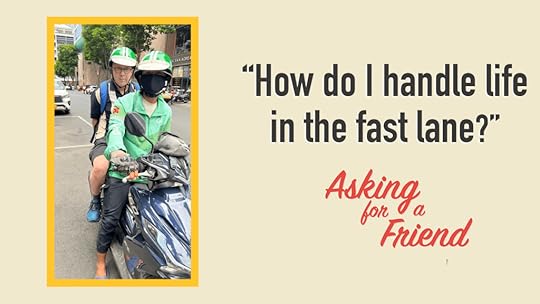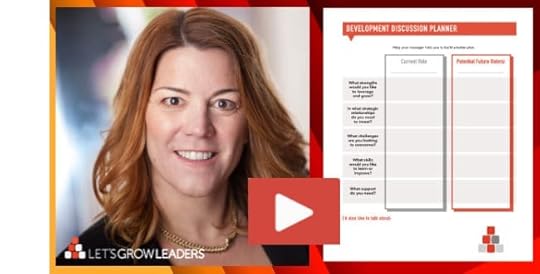David Dye's Blog, page 8
April 18, 2025
New Job, Fast Lane: How Not to Get Run Over in Your New Role
You’re excited about your new job. You want to make an impact.
And yet—it’s coming at you from all directions: Slack messages dinging like a fire alarm, meetings that could be emails, emails that could be lawsuits, and coworkers speaking in acronyms that sound like secret passwords.
So how do you hit the ground running without face-planting in your new job? Here are a few probe ways to get off to a fast and productive start.

When you first step into a new job, it’s like pulling up to a crowded curb in Ho Chi Minh City. Scooters everywhere. Horns blaring. People zipping off in every direction.
If you just grab the nearest one and take off—sure, you’re moving. But where? Fast doesn’t always mean smart.
Before you get swept into the motion, pause and ask:

“What does success actually look like in this new job—90 days from now, what would make you say I crushed it?”
This is your GPS moment. You don’t want to be the enthusiastic new hire doing donuts in the company parking lot because you missed the destination.
2. Tune Out the Frenetic NoiseEverything feels urgent. Not everything is.
Ask yourself:
What will move the mission forward?
What’s performative chaos?
Who benefits if I react… and who benefits if I don’t?
Get curious. Listen. But don’t volunteer to catch every spinning plate in your new job.
3. Find a Streetwise GuideYour workplace has a map. And someone knows it by heart.
It may not be your formal mentor. It’s often that plugged-in human who quietly gets things done while others are still forwarding the agenda.
Find them. Be curious. Ask for stories, not just advice. Ask:
“What do you wish you knew in your first month here?”
That one always sparks gold.
4. Learn the Rush HoursEvery office has them—even virtual ones. Want to connect with someone important? Don’t ping them when they’re knee-deep in fire drills.
Ask your teammates:
“When’s a good time to grab a few focused minutes with you?”
Strategic timing = better attention + less frustration. Think of it as workplace Waze for you new job.
5. Build Credibility Before You Need ItTake time to connect. Show genuine curiosity about your team’s priorities. Offer help before you need help.
As we say in our book, Powerful Phrases for Dealing with Workplace Conflict.
“Connection makes conflict easier, and collaboration faster.”
Even a 15-minute coffee chat today can save hours of spinning your wheels tomorrow.
6. Keep a “Wins and WTFs” JournalTrack your early wins, moments you felt lost, and what you learned. It’ll help you make sense of the blur and prep you for meaningful convos with your boss.
Ask yourself weekly:
What energized me?
What drained me?
What would I do differently?
This helps you own your story, not just survive it.
Final Word from the Saigon SidewalkAs you launch your new role, think less Formula 1, more Google Maps: orient first, then accelerate. And give yourself grace. It’s not about knowing everything—it’s about learning what matters most, fastest.
You’ve got this. And if you don’t, well… ask for a friend 😉
See Also: How can I be authentic at work and still fit in.
The post New Job, Fast Lane: How Not to Get Run Over in Your New Role appeared first on Let's Grow Leaders.
How to Disagree with Your Boss Using These Problem Solving Skills
Episode 299: How do you use your problem-solving skills to tell your boss “no”… without risking your job?
We’ve all been there—your boss makes a decision that feels wrong, risky, or just totally off. But speaking up? That feels like walking a tightrope over a pit of career-ending lava.
In today’s fast-paced, high-pressure environments, staying silent when you disagree with leadership can hurt your integrity, your team, and even your performance. But pushing back doesn’t have to mean burning bridges—it can actually boost your influence and credibility. This episode gives you the exact words to say and the approach to take.
Here’s what you’ll walk away with:
A powerful mindset shift to move from emotional reactivity to strategic influenceSpecific, non-threatening phrases to open tough conversations with senior leadersA step-by-step approach to disagreeing without drama—and maybe even strengthening your relationshipBuilding the Foundation with Problem Solving Skills00:57 – The moment of conflict that started it all
David opens up about a time he was asked to execute a plan that went against his values. This real-world scenario sets the tone for learning how to navigate disagreement with influence.
02:28 – Why staying silent costs more than you think
Avoiding conflict may feel safe, but it erodes your credibility and surrenders your opportunity to be seen as a strategic thought partner. Leaders need your perspective—even when you disagree.
03:19 – The conversation that comes first is with yourself
Before you say anything to your boss, you’ve got to check in with yourself. David shares a key question to ask that sharpens your intent and strengthens your problem solving skills under pressure.
04:17 – Reframing your mindset to lower emotional heat
Instead of reacting out of frustration, reframe your boss’s decision with curiosity. This shift helps you return to your values while staying calm, focused, and solution-oriented.
05:07 – Prepare like a strategic thought partner
This isn’t about complaining—it’s about presenting a compelling case. David walks through how to assess business risk, align with strategic goals, and strengthen your influence.
05:41 – The magic of aligning with what your boss values
Start the conversation by connecting to shared goals. David gives examples of language that shifts the tone from confrontation to collaboration, creating space for honest dialogue.
06:28 – Setting the stage for productive conversation
Timing matters. Don’t ambush your boss—schedule time and open with phrases that show you care about the team and the outcome. This respectful setup builds trust and lowers defenses.
07:46 – Listen deeply and reflect for mutual clarity
Want to really elevate your problem solving skills? Practice reflective listening. Use check-for-understanding phrases to confirm what you’ve heard and co-create a path forward.
08:23 – A surprising outcome that preserved integrity
David shares how his CEO responded with unexpected openness when approached the right way. The result? A solution that honored both perspectives and deepened the relationship.
09:26 – Even if you don’t “win,” you still grow
Not every conversation changes minds—but everyone reveals insight. Whether it’s alignment or a values clash, speaking up gives you the data you need to decide whether to stay or go.
The post How to Disagree with Your Boss Using These Problem Solving Skills appeared first on Let's Grow Leaders.
April 14, 2025
More Than a Chat: How to Make Your Career Conversations Count
Let’s talk career converations—and how to get the support you need to make them more meaningful.
Your manager can be one of your most powerful career allies. They can open doors, connect you with opportunities, and help you build the skills and relationships you need for what’s next. But even the most well-intentioned manager can’t read your mind. So the question becomes: How can you help your manager help you?
One tool that works brilliantly—whether you’re in-person or remote—is something we call the Development Discussion Planner. It’s straightforward, easy to use, and, more importantly, it works.
This is a tool you can use for yourself, and once you know how it works, you can also use it with your team members. It’s designed to bring clarity, structure, and momentum to career conversations that often feel fuzzy or awkward.
Start with a Role You Aspire ToBefore you talk with your manager, take a few minutes on your own. Think about a role you might want in the future—maybe it’s your manager’s role, something more senior, or a lateral move to a different department. You’re not locking yourself in. You’re simply creating a target to guide your learning and growth.
Once you’ve identified that future role, you’re ready to walk through five questions—first, for your current role, and then again for your aspired future role.
When you show up with these answers in hand, you’ve done the heavy lifting. You’ve given your manager a starting point and something concrete to respond to. That’s the magic of this planner: it makes it easier for your manager to truly support you.
The 5 Questions That Unlock Growth

Note: This video is part of our online human-centered leadership development video series. Learn more here.
1. What strengths would you like to leverage and grow?We always recommend starting with strengths. Where do you shine today? How might those talents apply to the role you want next? If they don’t align, that’s good information too—it might help you rethink what you’re aiming for. And your manager may see strengths you’ve overlooked.
2. In what strategic relationships would you like to invest?Growth isn’t just about skills—it’s about people. Who do you need to know to get ready for that next role? Who could champion your work, give you feedback, or help you learn what it takes? Relationships are often the bridge to opportunity.
3. What challenges do you want to overcome?This is a moment for honest reflection—and a chance to compare notes with your manager. What do you see as your biggest growth areas? Do they agree? You go first, then ask for their perspective. This builds trust and creates clarity.
4. What skills would you like to learn or improve?Think through what you’ll need to succeed in your desired role. What gaps do you see? What new skills could help you be more effective in your current job, too? Your manager might suggest additional skills or offer opportunities you hadn’t considered.
5. What support do you need?This is where it all comes together. When you ask for something specific—coaching, visibility, a project stretch—it’s far easier for your manager to say yes (or help you find the next best thing). Vague requests rarely move the needle. Specific ones? That’s where momentum lives.
You’re Not Just Asking—You’re LeadingWhen you walk into a conversation with this kind of clarity, it shows. You’re not just hoping to grow—you’re leading your development. You’ve done your homework. You’ve made it easier for your manager to say, “Yes, let’s do this.”
We’ve seen countless professionals and leaders use the Development Discussion Planner to spark powerful career conversations—and create real momentum. And once you’ve used it for yourself, you’ll find it’s just as effective when used with your team.
Q&A: Let’s Talk Career Conversations (Employee Perspective)Here are some of the most frequent questions we hear as our clients consider using the development discussion planner for career conversations.
Q: What if I don’t know what role I want next?A: You don’t need to have it all figured out to get started. Think of choosing a future role less like declaring a life path and more like picking a direction to explore. It’s just a tool to help you uncover your growth opportunities and start a meaningful conversation. Ask yourself: What kind of work lights me up? What problems do I love solving? Who do I admire—and why? You can also talk with your manager about a few possible paths and use the planner to test-drive more than one. Clarity often comes through conversation, not before it.
Q: What if my manager doesn’t seem interested in my career development?A: First—take a breath. This doesn’t mean you’re stuck or that your growth is on hold. Some managers just haven’t been trained to have these conversations, or they’re overwhelmed and don’t know how to support you. That’s where the Development Discussion Planner shines. It gives you the structure. You’ve done the thinking, you’re coming in prepared, and all they have to do is react. You might open with:
“I’ve been thinking about my growth and filled this out to help us have a focused conversation. I’d really value your perspective.”
If they still don’t engage? That’s useful data. Look for mentors or sponsors elsewhere in the organization who do care about development—and let this be your cue to build relationships that support your goals. Growth doesn’t have to come from just one person.
See Also: How to Warm Up Your Relationship with an Icy Boss
Q: What if my career goals don’t align with what my manager needs right now?A: That’s a great place for dialogue. If your aspirations don’t line up perfectly with the team’s current needs, talk about it. That doesn’t mean it’s a no—it just means you might need a longer runway or a creative path forward. Ask:
Q: What if I’ve had this conversation before… and nothing happened?“How can I contribute in a way that supports our goals and also helps me build toward where I want to go?”
Alignment doesn’t always mean immediate action. Sometimes it means a shared plan and a little patience.
A: Oof. That’s frustrating—and also a reason to try again, this time with a bit more structure. Use the Development Discussion Planner to bring specificity and momentum. Say,
Q&A for Managers: Leading Career Growth Conversations that Stick“I know we’ve talked about development before. I put together some thoughts using a tool I found helpful—can we revisit the conversation with this as a guide?”
And if things still stall? You may need to explore other growth channels—mentors, special projects, lateral moves—or take an honest look at whether your current role supports your future goals.
And, here are a few questions we hear from managers in our leadership development programs as they prepare to have these conversations with their teams.
Q: How can I use this tool to guide conversations with each person on my team?
A: Once you’ve experienced the Development Discussion Planner for yourself, you can flip the script and offer it to your team. Have your team fill it out first, just like you did. That way, they come into the conversation with clarity and ownership. Then your role becomes about listening, exploring, and helping them connect dots—not pulling ideas out of them in real time. Bonus: It helps you calibrate your development plans across your team without falling into one-size-fits-all thinking.
Q: How do I introduce this tool to my team without making it feel like extra work?A: Lead with purpose, not paperwork. Let your team know you want to support their growth—but you also know career conversations can get vague or stuck. This tool makes it easier for both of you. Try:
Q: What if a team member doesn’t know what they want next?“I’d love to have more focused development conversations with each of you. This tool helps you think through your goals and gives me a clearer way to support you. Take a look, reflect, and we’ll schedule time to talk through it together.”
Framing it as a shared investment in their future makes all the difference.
A: That’s okay—it’s part of the process. Encourage exploration over certainty. You might say:
Q: How do I follow up without micromanaging?“You don’t have to have it all figured out. Let’s use this as a way to uncover what energizes you and where your strengths could lead.”
Be curious. Ask about the types of work they enjoy, challenges they want more of, or people in the organization they admire. Sometimes clarity starts with conversation, not conclusions.
A: Easy—be supportive, not suffocating. Follow-through builds trust, and it doesn’t have to be heavy. After the conversation, ask:
Q: What if I’m not sure how to guide them in their goals?“What’s one small step you’d like to take in the next month? How can I help?”
Then, schedule a lightweight check-in to revisit progress. Even 10–15 minutes makes a big impact. It’s not about tracking—they just need to know you’re still in their corner.
A: You don’t need to have all the answers—you just need to ask great questions and connect them to people or resources who might. You can say:
“That’s a great goal, and I want to help. Let’s explore what support looks like. I may not have all the steps, but I’ll help you figure them out.”
Think of yourself less as the expert and more as the connector and advocate.
The post More Than a Chat: How to Make Your Career Conversations Count appeared first on Let's Grow Leaders.
April 11, 2025
7 Critical Communication Skills for First Time Managers to Boost Teamwork
Episode 298: Are you a new manager struggling to boost teamwork and communicate in ways that truly move your team forward?
This episode explores seven essential communication skills every first-time manager needs. Skills to reduce conflict, earn respect, and build a more collaborative, high-performing team.
You’ll learn how to set clear expectations to navigate the shift from peer to leader. Plus, have the right conversations to inspire trust, productivity, and accountability. These are real-world strategies that have helped countless leaders make the transition with confidence.
🎧 Tune in now to discover the communication skills that will help you lead with clarity, unlock your team’s potential, and create a culture of connection and results.
Navigating the Transition: From Peer to Leader[00:00] – Welcome + 7 Communication Skills for New Managers-
Host David Dye introduces the episode, promising seven critical communication skills to help first-time managers gain influence, reduce conflict, boost teamwork, and solve problems before they start.
[01:50] – The Challenge of Leading Friends and Former Peers-
David shares a personal story of leading a friend who was later fired. Highlighting how emotionally complex the transition from peer to leader can be.
[03:25] – Why Wanting to Be Liked Can Hurt Leadership-
The desire for acceptance can get in the way of making tough calls. David explains how leaders must embrace accountability—even when it risks relationships.
[04:40] – The Danger of Unclear Expectations-
Shifting into leadership requires clear boundaries. Without explicit expectations, both managers and team members end up feeling disappointed and frustrated.
[06:14] – Communication Skill #1: Lead Before You’re Promoted-
One way to ease the transition? Start acting like a leader before you’re formally promoted. This consistency builds trust and helps boost teamwork from the outset.
[08:07] – Communication Skill #2: Set and Clarify Expectations Early-
Use a conversation framework like “My intent is ___ so that we can ___” to openly discuss shifting roles. Transparency builds trust and creates the space to boost teamwork.
[10:07] – Communication Skill #3: Clarify the Hat You’re Wearing-
David suggests identifying whether you’re speaking as a friend or a leader in conversations. This reduces confusion and supports mutual respect in working relationships.
[10:59] – Communication Skill #4: Be Clear—But Stay Human-
Avoid pretending to be perfect. Your team already knows your flaws. Authenticity enhances trust and helps managers foster a culture where people feel safe to grow.
[12:18] – Communication Skills #5 & #6: Apologize + Weed When Necessary-
Own your mistakes with a thoughtful apology, and recognize when someone—friend or not—isn’t a fit. Protecting the team dynamic is key to boosting teamwork long-term.
[13:50] – Communication Skill #7: Find a New Peer Group-
You can still be friends with your team. You also need a leadership circle that understands your challenges. A new peer group offers perspective, guidance, and accountability.
The post 7 Critical Communication Skills for First Time Managers to Boost Teamwork appeared first on Let's Grow Leaders.
April 7, 2025
Left Out of the Loop? Here’s How to Step Back In with Confidence
You’re reading the latest executive update when it hits you: you’ve been left out of the loop—again. You didn’t miss the memo—there just wasn’t one.
You’re a key stakeholder. You own part of the work. Your team is affected. And yet somehow, you were left out of the conversation.
It’s not just frustrating—it’s disruptive. It slows progress, creates confusion, and adds unnecessary repair work. Worse, it sends a subtle message: You’re not essential here.
But you are. And the way you respond matters—not just for your influence, but for the tone you set across your team and peers.
You’re Not Overreacting—You’re Protecting AlignmentWhen you’re out of the loop on decisions that affect your scope, it’s not about being territorial—it’s about being responsible. When the right people aren’t in the room, outcomes suffer. Inclusion ensures:
Clear execution
Consistent messaging
Efficient workflows
Strengthened trust across teams
So yes, being left out of the loop matters. But how you bring it up determines whether you repair the misstep—or reinforce the divide.
What to Do First: Name It, Don’t Shame ItThe goal isn’t to embarrass anyone or make it personal. It’s to name the gap and reset expectations around how you work together.
Start by approaching the situation with clarity and curiosity:
“I noticed the decision around [X] moved forward—I wasn’t looped in, and it does impact my area. Can we align on how to stay connected for next time?”
This approach flags the issue without creating defensiveness. It reminds others of your role and shows your intent to collaborate. If being out of the loop becomes a pattern:
“I’ve noticed a few decisions that affect my scope have moved forward without my input. I want to make sure we’re coordinated—what can we shift to make that easier?”
You’re not blaming—you’re signaling that the current approach isn’t working and inviting shared responsibility for improving it.
Don’t Assume It’s Personal—But Don’t Normalize It EitherPeople are busy. They’re moving fast. They may assume you’re in the loop, or that it’s easier to ask forgiveness than permission. Sometimes it’s a slip. Other times, it’s a sign that your team agreement needs attention.
Repeatedly being left out of the loop—intentional or not—requires a reset. If you let it slide, it becomes a silent standard. If you react emotionally, others may shut down. The most effective move? Stay calm, be direct, and focus on repairing the system—not just the moment.
What If It’s Your Boss Who’s Leaving You Out of the Loop?This is a different kind of challenge. When the person keeping you out of the loop is your manager, it’s harder to speak up. You’re navigating hierarchy, trust, and the fear of seeming over- sensitive or defensive.
sensitive or defensive.
But here’s the truth: if you’re responsible for delivering a part of the work, you need visibility into the decisions that shape it. That’s not politics—it’s accountability.
Try framing the conversation in a way that supports their success, too:
“I noticed some decisions around [X] moved forward, and I wasn’t part of those conversations. Since I’m accountable for this piece, I’d love to be more involved earlier—what’s the best way to make that easier for you?”
You’re showing initiative, not defensiveness. If it’s happening repeatedly:
“I’ve been in catch-up mode on a few things that impact my work. Can we align on when I should be brought into the conversation so I can stay ahead of what’s coming?”
This helps your manager understand the impact of keeping you out of the loop—without putting them on the defensive.
Normalize Better NormsYou shouldn’t have to chase inclusion every time. The better play is to help create norms and systems that support clarity across the board:
Build shared stakeholder maps: Who owns what? Who needs to be consulted?
Use pre-decision prompts: “Who else is impacted by this?”
Reinforce habits in meetings: “Before we move, are we sure the right people are in the loop?”
Normalize inclusive language: “Let’s check with [X]—they own that piece and should weigh in.”
When inclusion is a habit, being out of the loop becomes the exception—not the norm.
Phrases That Keep the Conversation ConstructiveWhen you’ve been left out:
“This decision impacts my area—I’d like to align before we move forward.”
“I want to make sure my perspective is considered, since I’m connected to this outcome.”
“Can we agree on a better way to keep stakeholders involved early on?”
When you’re trying to shift the pattern:
“What would make it easier for you to know when I need to be included?”
“Let’s define who needs to be at the table before we move this ahead.”
“I want to help us avoid rework—how can I plug in earlier next time?”
The key is using language that invites alignment—not blame—even when you’ve been left out of the loop.
Bottom LineBeing out of the loop doesn’t mean you’re powerless. The way you respond can shift relationships, shape team dynamics, and reestablish clarity around your role.
Don’t internalize it. Don’t escalate it. Reset it.
You’re a stakeholder. Own your space. Invite others to meet you there.
The post Left Out of the Loop? Here’s How to Step Back In with Confidence appeared first on Let's Grow Leaders.
April 4, 2025
How to Influence Your Boss and Share Critical Feedback
Episode 297: How do you give critical feedback to your boss without risking the relationship, overstepping, stressing out, or burning bridges?
You’re juggling priorities, managing a team, and trying to meet expectations. But what happens when your manager’s decisions create more chaos than clarity? In this episode, you’ll get practical tools to shift that dynamic and build a stronger, more strategic relationship with your boss—no drama required.
Here’s what you’ll walk away with:
A mindset shift and strategy to understand what really drives your manager (and their manager).Communication techniques to present ideas that actually get traction—backed by data and story.A smart, respectful way to say no or share feedback without damaging the relationship.Hit play now and learn four proven communication tactics that will help you influence up and take more control of your work life.
Shifting Your Mindset to Influence Up⏱ 0:00 – What this episode delivers.
David kicks things off with a listener-favorite question: How do I influence my boss? He explains how these four communication skills will help reduce overwhelm, build trust, and create a stronger working relationship.
⏱ 2:00 – You can’t change your manager, but you can influence them.
Learn why influence starts with understanding—not control—and how shifting your mindset can give you more clarity and confidence.
⏱ 3:45 – Start with two-level thinking.
To truly influence your boss, you need to know what matters to their boss. David explains how identifying goals, problems, and pain points two levels up unlocks strategic alignment.
⏱ 5:45 – Make the business case with data and story.
Don’t just present numbers—make meaning out of them. David shares how combining data with a clear recommendation and relatable story makes your message stick.
⏱ 7:20 – Anticipate questions before they’re asked.
Avoid getting blindsided in the moment by thinking like your boss. Anticipating their most obvious questions helps you stay composed and credible.
⏱ 8:45 – Say yes to say no.
Instead of rejecting requests outright, David outlines how to affirm shared goals while offering alternatives—a respectful way to protect priorities without damaging the relationship.
⏱ 11:35 – The only approach that works for giving critical feedback.
When it’s time to speak up, permission is key. David shares a technique to offer critical feedback to your boss in a way that invites dialogue, not defensiveness.
⏱ 13:45 – How asking permission changes the tone.
Positioning your feedback as support for your manager’s goals opens the door for influence. David explains how this approach keeps the conversation constructive.
⏱ 15:30 – What to do if your boss doesn’t want feedback.
If your manager declines, respect the boundary—but don’t lose heart. David reminds you to focus on building credibility so you’ll have more influence in the future.
⏱ 16:17 – When and why to give critical feedback at all.
David closes with a reminder: not all feedback is worth sharing. Choose moments that matter for team health and your own mental wellbeing—and where critical feedback truly serves the bigger goal.
The post How to Influence Your Boss and Share Critical Feedback appeared first on Let's Grow Leaders.
April 2, 2025
My Team is the Underdog! How do I Motivate Them Now? #AskingforaFriend
You know that feeling. The buzzer just sounded. You and your scrappy band of underdogs are stepping onto the court, and it’s clear the other guys are taller, faster, and, let’s be honest, a whole lot shinier. You’re the 16th seed. They’re the number one. But this isn’t March Madness—this is Tuesday morning. And instead of basketballs, you’re juggling budgets, deadlines, and skeptical execs.
Your team is the underdog.
And while underdog stories are awesome on the screen (cue the slow-motion montage and inspiring music), leading through them in real life is a different kind of hustle. You can’t just believe harder. You’ve got to lead smarter. So, how do you inspire a team when you’re not just behind—you’re underestimated?
Let’s talk strategy.

Underdogs don’t win by accident. They win because they’re playing with purpose. When the scoreboard isn’t in your favor, your people need to know: Why are we still in this game? Why does what we’re doing matter?
Start there. Find the meaning behind the mission—even if it’s buried under spreadsheets and “ASAPs.” Maybe your team’s product makes life easier for someone who’s overwhelmed. Maybe your internal project could pave the way for a more inclusive culture. Don’t assume they see it. Draw the line from their work to something bigger. And say it often.
When you remind people that they’re not just pushing paper—they’re pushing possibility—they play harder.
2. Call the “External Threat” Play (Just Not the Scorched-Earth Version)Look, I’m not saying you should manufacture drama. But there’s nothing wrong with a little friendly fire to spark motivation.
Let the team know there’s a number-one seed out there—maybe it’s a competitor, or another team chasing the same innovation. You’re not vilifying them; you’re clarifying the stakes. “They don’t think we can do this.” That sentence has lit a thousand locker room fires.
Done right, this isn’t about resentment—it’s about resolve. The goal is to unite your team around a shared challenge, not a shared enemy.
3. Know Who’s Got the Sweet Corner ThreeEvery team has unsung superpowers. The analyst who spots trends others miss. The junior dev who quietly builds elegant fixes. The admin who holds the whole thing together when it feels like it’s falling apart.
Name those strengths. Out loud. In front of everyone.
Underdog energy thrives when people feel seen for what they uniquely bring. Build your game plan around their strengths. Want even more buy-in? Ask them, “What’s the one part of this challenge where you feel you could bring the most impact?” Then let them own it.
4. Practice Like a Championship Team (Even If You’re Still in Warm-Ups)You don’t just hope your team performs under pressure—you prepare them to. Identify the vital habits that will make or break your momentum. That could mean closing the loop on every customer follow-up within 24 hours. Or holding each other accountable for flagging risks before they escalate. Or celebrating every tiny win, loudly.
The plays that win games aren’t always flashy. They’re consistent.
Pick your vital few. Practice them religiously. Let the habits become muscle memory.
5. Run the Plays. Watch the Tape. Adjust. Repeat.Underdogs don’t get to coast. You can’t afford wasted effort or misaligned assumptions. Set a cadence of check-ins—not to micromanage, but to calibrate.
Ask: What’s working? Where are we stuck? What’s next?
Think of these like watching game tape. Not to assign blame—but to get sharper with every possession. And keep it human. These check-ins should feel like locker room huddles, not quarterly reviews.
Final Play: Make It PersonalWhen the odds are against you, every voice matters more. Every choice, every contribution, every ounce of energy adds up.
Note: If you’re looking for an inspiring “come-from-behind” case study, check out chapter 6 of our book, Courageous Cultures: How to Build Teams of Micro-Innovators, Problem Solvers and Customer Advocates where I share a story from my time as a Verizon sales executive.
The post My Team is the Underdog! How do I Motivate Them Now? #AskingforaFriend appeared first on Let's Grow Leaders.
March 31, 2025
Wisdom at Work: What Wise People Say When Stakes are High
You’ve probably worked with someone you’d describe as having wisdom at work. They don’t always talk the most, but when they do, everyone leans in.
They don’t overreact, overpromise, or overpower. They just… bring something different. Grounded presence. Clarity about what matters most. Calm under pressure that feels contagious.
And maybe, you’ve wondered—how do I become more like that?
Here’s the good news: wisdom doesn’t come with a title. You don’t even need gray hair (although at this point in the game, we wish that gray hair would make us more wise;-).
We’ve worked with some wonderfully wise, young, human-centered leaders. And of course, we’ve met our fair share of impulsive short-sighted executives with plenty of gray (or no hair at all) calling the shots.
Wisdom is something you practice. And the workplace needs it now more than ever.
So, What Is Wisdom at Work?It’s not about being the smartest person in the room. It’s not about knowing all the answers or quoting the latest research (unless it’s ours 😉. Wisdom at work shows up in how you respond when things are messy, unclear, or emotionally charged.
Wisdom at work includes the ability to pause before reacting, ask a better question instead of making a louder point, and choose words that move the conversation forward instead of just proving you’re right.
Wisdom shows up in the ability to dance with clarity and curiosity, as we talk about in our book, Courageous Cultures. And, “landing in the AND” of confidence and humility, results and relationships, as we teach in our leadership development programs.
Where Does Wisdom at Work Come From?Of course, it wouldn’t be wise for us to think we could teach this in three paragraphs in a blog post. But here are a few thoughts on where to start.
Grow from experience: Wisdom comes not just from experience, but what we learn from those experiences and what we DO with those experiences. For example, if we have a big regret, what do we learn from it? (see also Karin’s interview with Dan Pink on regrets)
Gain a broader perspective: Putting yourself into uncomfortable situations where people are smarter than you (in the same way, or different ways). To deliberately work in areas you’re not good at, or to take on projects you’ve never tried before. We find travel, particularly when we’re engaging and collaborating with people in other countries, provides amazing opportunities to broaden our perspectives and challenge our assumptions. For example, as we write this, we are preparing for a two-week courageous leadership adventure in Vietnam where we will speak, teach, learn, volunteer, and grow.
Learn from others: Research. Read. Listen. Watch what’s working for others (and, even more importantly what’s not). One of our favorite, practical techniques to get feedback is what we call a DIY (Do It Yourself) 360. More here.
5 Practical Ways to Be More Wise at WorkWhile you can’t always control what’s happening around you, you can choose to show up wiser—moment by moment, conversation by conversation.
1. Slow the conversation down.Wisdom rarely rushes. When things get heated, wise leaders breathe instead of bulldozing.
Try: “Let’s take a breath here before we decide.”
Or even: “Can we hit pause? I want to be thoughtful about this.”
People absorb your tone, your energy, your micro-reactions. Wisdom is contagious—but so is anxiety.
Before you respond, ask: “What’s the impact I want to have in this moment?”
Wise people don’t jump to solutions—they dig deeper.
Try: “What’s the real tension here?” or “What do we need to understand before we act?”
You don’t need to fill the silence. Some of the wisest people we know say less, but every word counts.
Aim for clarity, not volume. One well-placed question or summary can shift the entire room.
It’s tempting to defend your turf or “win” the moment. But wisdom plays the long game.
Try: “What’s the best next step for the team?” even if it’s not your idea.
That’s not weakness—it’s leadership.
You might be wise—but if it doesn’t land that way, it’s not helping.
Ask yourself:
When I speak, do people get quieter—or more defensive?Do colleagues seek my input on difficult issues, not just easy ones?Do people feel calmer, clearer, or more capable after talking to me?If not, don’t panic. But do reflect. Wisdom isn’t just what you intend—it’s how you’re experienced.
Sometimes, the wisest move is to ask for feedback:
“When we’re in the middle of a tough moment—how do I show up for you?”
Just a few thoughtful lines that open space for real conversation.
Here are a few that carry weight:
“I’m sitting with two truths that feel in tension. Can we talk about that?”“There’s a lot we don’t know yet. Let’s name that before we rush to a fix.”“That’s a strong reaction—can you help me understand what’s underneath it?”“I don’t need to win this—I want to get it right.”“What’s the wisest way forward, even if it’s not the easiest?”Final Thought: Wisdom Is a ChoiceEvery meeting, every moment—you have a choice. To react or reflect. To defend or explore. To power through or pause.
And the more often you choose the path of wisdom, the more people will trust you, follow you, and seek you out—not just for answers, but for perspective.
So keep showing up. Keep choosing presence over pressure. You don’t have to have all the answers. You just need to show up wise—one phrase, one breath, one choice at a time.
The post Wisdom at Work: What Wise People Say When Stakes are High appeared first on Let's Grow Leaders.
March 28, 2025
6 Overlooked Leadership Skills To Run Meetings That People WANT To Attend
Episode 296: Are you running meetings that drive real results—or just draining everyone’s time and energy?
Let’s be honest: no one hates meetings—they hate the ones that feel pointless. If your team’s meetings often end with vague action items, low engagement, or zero follow-through, it’s not just frustrating—it’s hurting your leadership credibility. This episode gives you the tools to turn that around and lead meetings your team actually wants to attend.
Here’s what you’ll walk away with:
Six practical techniques to lead meetings that drive action, boost morale, and build trust.A foolproof framework to clarify purpose, decision-making, and outcomes—every single time.Simple, powerful questions that guarantee your meeting ends with real commitments and momentum.Press play now to start running meetings that energize your team and elevate your leadership.
Foundational Shifts To Run Meetings Better[00:58] – Most meetings fail because they’re time-wasters; learn why respecting time is the first step to reclaiming your leadership credibility.[03:59] – Meetings must produce action. If your meeting doesn’t move the mission forward, it shouldn’t happen.[05:04] – Don’t overlook the relationship-building side of meetings—especially with hybrid or virtual teams.[07:03] – Get intentional about who you invite. The smallest group of diverse, relevant stakeholders leads to the best decisions.[09:50] – Clarify what kind of meeting you’re leading. Confusing an info session with a decision-making meeting leads to frustration and inefficiency.Techniques That Drive Action and Ownership[11:39] – To run meetings that result in action, be crystal clear about who owns the decision and how it’s being made.[13:27] – Break down the three most effective decision-making styles and when to use each one to keep your team engaged and on board.[16:52] – Meetings are commitment creators. Every great meeting should end with clear ownership and next steps.[19:04] – Run meetings with intention by asking three game-changing questions: Who will do what, by when, and how will we know?[22:49] – If you skip the follow-through, you’ve wasted more than time—you’ve eroded trust. Run meetings that finish strong and create lasting momentum.Leadership Skills to Run Meetings that People Want to AttendHere are the six advanced leadership techniques for running meetings that get results and that people actually want to attend:
Don’t waste their time
Only hold meetings when they’re the most valuable use of everyone’s time. Respect the precious resource of time by being intentional and efficient.
Know your outcomes
Every meeting should have a clear purpose, focused on building relationships and achieving results. Define what action or outcome you expect.
Get the right people in the room
Invite the smallest group of stakeholders necessary to make the best decision, ensuring diverse perspectives and relevant input.
Clarify what kind of meeting you’re having
Be clear whether it’s an informational meeting or a decision-making/problem-solving session—don’t mix the two.
Clarify who owns the decision
Clearly state how the decision will be made (e.g., one person decides, group consensus, or vote) to avoid frustration and confusion.
End with commitments and next steps
Close every meeting by answering three questions: Who will do what? By when? And how will we know? This ensures accountability and real follow-through.
The post 6 Overlooked Leadership Skills To Run Meetings That People WANT To Attend appeared first on Let's Grow Leaders.
March 27, 2025
The Most Overlooked Part of Difficult Conversations? Location, Location, Location.
If you’ve ever been blindsided by feedback via Slack, had your stomach drop at a cryptic text from your boss, or—yes, it happens—been let go over Zoom, you’re not alone. One of the most common complaints I hear about difficult conversations is where they are held.
We talk a lot about what to say in a difficult conversation, and how to say it—but we don’t talk enough about where that conversation should happen. Venue matters. A tough message dropped into a chat app at 4:57 p.m. on a Friday can land very differently than the same words spoken over video with care and context.

A few weeks ago I shared a (as it turns out, quite popular article and video) on building a Team Agreement—or what we like to call the Couth Code. It’s the set of unwritten-but-should-be-written rules that keep your team running with respect, responsiveness, and professionalism.
Managers often assume everyone just knows how to have a sensitive conversation. But as we’ve learned—just because something feels like common sense doesn’t mean it’s common practice.
And this is one of those places where alignment matters. Managers need to be talking with their HR partners, not just about policies, but about practice. About what’s couth, what’s not, and how we want to show up for people when things get hard.
Why Does This Keep Happening?So why do people default to text or Slack for difficult conversations? Sometimes it’s a lack of confidence—they’re avoiding the discomfort of seeing the other person’s reaction. (If I don’t have to see them get upset, maybe it won’t feel so bad.) Other times, they genuinely don’t know any better. We “learn” from others. It’s statistically likely that managers who struggle with this got dumped over WhatsApp, ghosted after interviews, or fired by email themselves. They never had a model for what good looks like. And when no one teaches couth, people revert to convenience.
But just because it’s faster, doesn’t make it kinder—or more effective.
Let’s Talk It Through: Common Scenarios to Align OnWant to raise the bar on your team or org? Start here. Have a conversation around a few of these scenarios:
Where do we give developmental feedback?
What’s the right setting to deliver a layoff or performance warning?
When is it okay to use text or Slack—and when is it definitely not?
How do we want to handle interpersonal tension when it’s remote vs. in person?
What’s our process when emotions are running high?
These are the kinds of norms that make it into your Couth Code. And once you’ve talked them through, you can teach them, reinforce them, and hold each other accountable.
A Few Quick Guidelines for Where to Hold Difficult ConversationsWhile there’s no one-size-fits-all answer, here are a few principles to help you choose the right room for the conversation:
Feedback should never be a surprise—especially in writing. If you’ve never had this particular difficult conversation before, don’t start with an email.
Use synchronous when the stakes are high. If there’s emotional weight or nuance, go face-to-face or camera-on whenever possible.
Ask yourself: “How would I want to receive this message?” Then adjust your approach to this difficult conversation to honor that same dignity.
When in doubt, say this: “This deserves a real conversation.” It’s a gentle way to pause the ping-pong of digital back-and-forth and elevate the dialogue.
The where sets the tone for how the message lands. So before you hit “send” on that tough message, take a beat. Choose a place that makes space for courage, clarity, and care.
If you’re a people leader or HR pro, talk with your team this week. Choose a few tricky situations and ask: What’s the couthful way to handle this here?
You’ll be amazed how much alignment (and relief) that one conversation can create.
The post The Most Overlooked Part of Difficult Conversations? Location, Location, Location. appeared first on Let's Grow Leaders.






